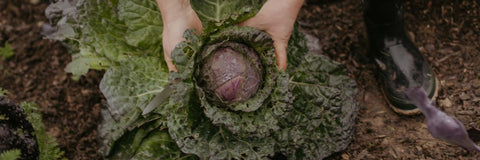In a culture where only a few select cuts of meat make it into our kitchens, we’ve lost touch with the deeper ethics and wisdom of eating animals. At My Little Farm, we believe in a return to whole-animal eating — also known as nose-to-tail — not just because it’s better for our health, but because it’s more respectful, more sustainable, and deeply rooted in ancestral knowledge.
Respecting the Animal
When we choose to eat meat, we make a significant decision — one that involves the life of another being. Honouring that life means using the animal fully. Nose-to-tail eating is about gratitude. It’s about moving away from the industrial detachment that sees animals as units of production, and toward a mindset of reverence and responsibility.
Using every part of the animal — from muscle meat and organs to skin, bones, and fat — ensures nothing is wasted. It shifts us from consumers to stewards. When we make broth from bones, slow-cook the tougher cuts, and learn to appreciate the rich nourishment of organ meats, we close the loop. This is how humans have eaten for millennia — with care, intention, and resourcefulness.
Nature’s Multivitamins
Organ meats are nutritional goldmines.
Modern diets are often rich in calories but poor in essential nutrients. Nose-to-tail eating offers a counterbalance: foods that are deeply nourishing, rich in the very things our bodies are often starved of — fat-soluble vitamins (A, D, E, and K), iron, zinc, selenium, choline, glycine, and naturally occurring collagen.
Liver, for example, is one of the most nutrient-dense foods on the planet. It provides vitamin A in its most bioavailable form — critical for fertility, immunity, and skin health. Heart is rich in CoQ10, essential for energy production and cardiovascular function. Bone broth provides glycine and gelatine — soothing to the gut and connective tissues, and balancing to the high methionine content of muscle meat.
Eating only muscle meat can lead to an imbalance of amino acids over time. Nature never intended us to eat that way — the whole animal contains a spectrum of complementary nutrients that work in harmony to support human health. Nose-to-tail eating restores that balance.
Ancestral Traditions
Our ancestors didn’t need nutrition labels or health gurus to know which foods were most powerful. Across cultures, organ meats were not discarded — they were revered. They were the first to be eaten after a hunt or slaughter. They were set aside for pregnant women, elders, and the sick — those who needed the most potent nourishment.
From the Inuit to the Maasai, the Sami to rural European villages — traditional people prioritised organs. Not out of frugality, but because they recognised their strength-giving properties. This was wisdom passed down through generations. These communities flourished without multivitamins or fortification — because they ate nose-to-tail.
Returning to this way of eating is about more than nutrition. It’s about reconnecting with ancestral rhythms, seasonal cycles, and the idea that food is medicine.
5 Practical Ways to Implement Nose-to-Tail Eating
Embracing this way of eating doesn’t have to be overwhelming. Here are five accessible ways to bring more of the animal back to your plate:
1. Get Creative in the Kitchen
There are so many delicious ways to cook with organs and traditional cuts. From liver pâté to oxtail stew, the possibilities are rich and satisfying. We’ll be sharing some of our favourite nose-to-tail recipes soon to inspire your next meal.
2. Hide It in Recipes
Not everyone loves the taste of organ meats right away — and that’s okay. We love keeping frozen liver in the freezer and grating it into stews or dishes like bolognese or shepherd’s pie. We promise — you (or your kids) won’t even notice it. Bone marrow can be stirred into stews or mashed potatoes for extra richness (recipe coming soon!).
3. Use Capsules
If you’re not ready to dive in headfirst, freeze-dried organ capsules are a great place to start. They offer many of the same benefits without the taste or prep. We particularly like the organ capsules from APE Nutrition. They’re made from high-quality, grass-fed and regeneratively raised animals.
4. Make a Weekly Batch of Bone Broth
Bone broth is a deeply nourishing way to use the whole animal. You can include all sorts of bones, cartilage, connective tissue, chicken feet — even pig trotters (though be warned, they make a strong-flavoured broth!). Use it in soups, stews, risottos, or simply sip it warm from a cup.
5. Don’t Forget the Skins and Hides
While not part of the diet directly, this matters just as much. The skin is the largest organ of the body — and often overlooked. We were shocked to discover that most sheepskins are incinerated after slaughter. Yet they make beautiful, natural additions to the home — perfect as a rug, seat cover, or thermoregulating pram liner for a baby. It’s another way of honouring the animal fully, and reducing waste.
Final Thoughts
Eating nose-to-tail is about reclaiming our relationship with animals, food, and health. It invites us to slow down, to be intentional, and to restore a sense of wholeness — in our kitchens and on our plates.
It’s not about perfection. It’s about reverence. A deep bow to the animal. A quiet return to wisdom. A step toward nourishing ourselves — and the land — more fully.
Want to Eat This Way, Too?
At My Little Farm, we don’t just write about nose-to-tail eating — we live it.
We raise primitive breeds with care and intention, and provide our members with access to nutrient-dense, regeneratively farmed meat, dairy, eggs, and more — all produced without pharmaceuticals, shortcuts, or compromise.
If you're looking for a trusted source of food that aligns with your values, we’d love to welcome you into the community.
Become a Member from £100/year
Together, we’re reclaiming the wisdom of the past to build something better for the future — one animal, one meal, one step at a time.




Comments (0)
There are no comments for this article. Be the first one to leave a message!